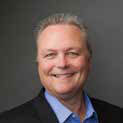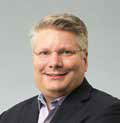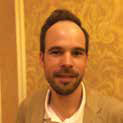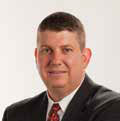
For most, the warmer temperatures and longer days are the first signs of summer. But in the AV world, the same signs indicate it’s almost time for the largest gathering of industry professionals in the United States. Yes, we’re only one month out before the 2016 InfoComm Show, held this year in Las Vegas from June 4 to 10. We spoke with some of the top manufacturers in the industry about what they are most looking forward to at this year’s show, from technology trends, products, and education.

“Network design. The trends impacting our industry— IoT, cloud, management, security, convergence— are interesting, exciting, and important, but the overarching requirement for AV integrators is to understand the design of a network (what are the factors involved in delivering AV streams to the RJ45 port in the wall?). As an industry, we should have requisite knowledge of the issues facing IT. As more AV products are placed on IT networks, constructive conversations on network design choices will get jobs done faster and more efficiently.”
—Shell Haffner, director of product management, Biamp Systems

“The trends we will be looking for at InfoComm 2016 include features and enhancements that we can provide for our customers at the work surface (table top) through our table boxes; increased connectivity, device charging, and ease of installation are features that we continue to look to integrate into our products; anything new and exciting in HDMI and HDBaseT signal extension and switching; and changes in equipment storage in technology rooms. Space for equipment racks is getting harder to come by. We are looking for ways to help our customers with this challenge.”
—Chaz Porter, director, global sales, FSR

“For InfoComm 2016, Lightware will be showcasing solutions focused on command and control, huddle spaces, and digital signage. We’ll also be showcasing professional technologies centered on 4K and HDBaseT. While we’ll be highlighting some new matrix and extender products, one product we feel really stands out—our Lightware 8x8 HDMI 2.0 matrix.”
—Drew Taylor, director of consultant and partner relations, Lightware USA

“Network-based systems are a trend that’s continuing to grow—larger and smarter systems like these are proliferating in the market right now. Whether it be AVB, Dante, or AES67, there are now a wealth of products out there that are all communicating with one another. We’re starting to see smarter systems being built that use these technologies.”
—John McMahon, vice president of solutions and strategy, Meyer Sound

“We’re looking forward to seeing the industry embrace USB 3.1 and push the boundaries of interactivity as more manufacturers integrate it into their product designs. It will give us a chance to demonstrate the flexible options for overcoming the length limitations of the technology, especially in applications like active learning classrooms.
Product features that save space and make the integrator’s job easier never go out of style. We believe that InfoComm attendees will walk away with some exciting and unexpected new options for power distribution and component protection that go above and beyond to maximize the space in racks and furniture.”
—Timothy Troast, director product management at Middle Atlantic Products

“System integrators should be on the lookout for corporate AV solutions that break the ties to hardware, and align themselves with software-based (and cloud-based) paradigms, rooted in true IT standards. Changing out gear every few years has been replaced by pushing firmware. Investing in antiquated DSP chip-based technology leaves no room for future engineering and expansion. This paradigm has been all but replaced by a far more powerful, smarter model that is better suited to evolve with the flow of technology. QSC is thrilled to be launching several products this year at InfoComm that are going to reinforce the concept of “software-based functionality” on its Q-SYS platform for corporate AV.”
—Patrick Heyn, director of marketing (Systems), QSC

“Although we’re all hearing quite a bit about this phrase, I do feel that IoT will be a continued growing theme for the years ahead. If you consider that the trend of interconnectivity and AV/IT convergence was essentially ‘chapter one,’ we’re well into chapter two with IoT. This is an excellent opportunity for AV integrators, consultants, and architects, as it will require advanced expertise to design, integrate, and support these types of solutions for their end users. End users will require that advanced systems just work—not only within a single facility, but also across numerous locations (i.e. campuses) and continents. Fluid operability across any device (mobile, tablet, laptop, etc.) in any environment (office, home, car, airplane, etc.) is rapidly becoming the expected norm.”
—Stephen Kohler, senior director, marketing, Shure Incorporated
“InfoComm is the who’s who of technology. In previous years, we saw a considerable amount of projection-based AV technology. But today, the best and brightest leaders in that space are doing some incredible things with projection mapping, and that is a fun trend to follow. One really interesting change we’re seeing (and of course are an active part of) is the ever-evolving and rapid growth of LED capabilities. We expect to see the latest generation of LED products featuring ultra-fine pixel pitches again this year.
There’s a tremendous amount of work being done at an industry level to fine-tune the color gamut as well—LEDs are considered superior to LCDs in that regard, so we’ll be interested to see what’s new in both areas. Sensors and software add-ons have reached “must-have” status in the display world, and we expect to see some explosive growth in diverse and creative content usage. At NanoLumens, we’re ahead of those trends and we’re always ready for a little friendly competition—there’s mutual respect between competitors in our industry.”
—Jeff Crowley, SVP of global channels and EMEA, Nanolumens

“From an industry standpoint, there are several technology trends that continue to emerge and develop—4K and laser projection, but also IP transmission—so there will be a lot to talk about in Las Vegas.
For Sony, the big attraction to our exhibit will be a revolutionary type of display technology for public spaces and high-end visual entertainment. I can’t say too much about it now, but this will surely be the “can’t miss” technology of the show that everyone has to come and see.”
—Mark Bonifacio, director, sales & marketing, visual presentation solutions, Sony Electronics

“Simplifying connectivity and control will continue to be trends. Dante networking has been a mainstay for connectivity in Yamaha products for many years, and the integration of device discovery and network health tools like our new SWP1 Level 2 switch brings convenience and reliability to AV integrators. Our Commercial Installation Solutions (CIS) line brings efficiencies to distributed systems for speed of installation and simplified programming, and the Yamaha ProVisionaire Touch software for iOS provides a quick and powerful tool for creating user controls for these systems.”
—Marc Lopez, director of marketing, Yamaha Professional Audio

“There are two major technology trends that have been rumbling for a few years, and this will be the year that we will see a major shift in the market: AVB will be a decision feature on enterprise switches, and the huddle room running software UC clients will become the solution of choice.
Why is AVB finally going to be making noise? Cisco has introduced AVB on their Nexus family of switches. They are not the first but have been the one that everyone has been watching; with this announcement, the assumption is they have finally decided to introduce AVB into their offerings. As these switches start to roll out, the AV industry will pivot to start to leverage the products that will take advantage of this underlying technology. With the Executive Elite family, Revolabs is poised to ride this transition in the enterprise market.
The huddle room will start to make real traction as the technology to enable software UC clients from companies like Microsoft, Google, Zoom, and Cisco (Spark) will fractionalize the price points of the tradition videoconferencing products. IT managers can now put full video UC solutions into rooms that were only outfitted with speakerphones in the past. This will change the complexity of what IT technology is focused on for 2016.”
—Tim Root, chief technology officer and EVP of new business development, Revolabs
One More Thought: What is the most important learning experience you hope to share with integrators this year?
“As for sharing learning experiences with integrators, infrastructure is the most expensive aspect of an AV project to change down the road. We therefore strive to work with integrators, learn as much as we can about the infrastructure portion of a project design together, and help our customers be prepared for the future.”
—Chaz Porter, director, global sales, FSR
“I hope that integrators will be able to learn about some of Meyer Sound’s products and systems that are being used in corporate and educational spaces that may not have even been considered in the past. Integrators and consultants haven’t really been aware of the amount of business that we’re doing in those spaces with our Constellation acoustic system for acoustic focus and voice lift solutions.
“The ability to control acoustics is now not just an option, but a must-have in many applications. Integrators and consultants may not be aware of all the opportunities to go after in corporate and education applications. People have traditionally looked at active acoustic technology for concert halls and multi-use performing arts centers, but there is equal, if not greater opportunity to incorporate this technology into corporate and educational spaces.”
—John McMahon, vice president of solutions and strategy, Meyer Sound
“Careful planning of AV infrastructure will lead to reliable meeting spaces that empower people to connect and collaborate. InfoComm’s attendees have a chance to see those latest technologies the industry has to offer and they may walk away from the show with excitement to integrate these new solutions, but they also need a solid game plan for the physical infrastructure support for these technologies.
“That’s where we have a chance to demonstrate the crafty ways for mounting them, including rack-mount components suspended underneath a desk surface and smart spaces to store small devices. Moreover, we want integrators to be prepared to address the needs of the system when full-scale racks are not an option. In many respects, integrators are in the furniture business now, and it’s more critical than ever to understand how to choose furniture that is optimized to handle the needs of the ever-changing AV system.”
—Timothy Troast, director product management at Middle Atlantic Products
“We actually have two key strategic initiatives this year in regard to our Preferred Partner Integrators: The first is “Elevate the Audience”—it is our focused, collaborative approach with our partners where we create increased connectivity with chief decision makers (CEO/CFO/ CTO/CIO). By plugging in the essential stakeholders to the same communication channel, we ensure clear and accurate information is exchanged at every stage of the project, increasing success rates and underscoring NanoLumens’ commitment to quality.
“Second is our new ADVANTAGE Program, a truly game-changing approach to technology obsolescence. Through our best-in-breed technology renewal program and our integration partners, customers can now renew their display solutions every five years, spread out payments monthly, and receive top-notch service and support.”
—Jeff Crowley, SVP of global channels and EMEA, Nanolumens
“Our integrators are our most valuable partner; we are constantly sharing our best-of-breed secrets with them. To give a glimpse into this list, Revolabs has had some significant wins in the UC enterprise market. Companies are replacing their traditional star phone or USB speakerphones with a single FLX UC1000 with superior quality. We are sharing how we have developed a wizard that will step an IT director through the process of configuring a UC1000 on a Cisco call manager environment. This takes the risk out of adding a non-Cisco phone to their network, which helps the IT organization look at other options for their spaces.”
—Tim Root, chief technology officer and EVP of new business development, Revolabs
“We should all remember that, despite these rapid advances in technology, end users need solutions that are absolutely as easy to use as possible. As an industry, we run the risk of falling in love with our gadgets, etc. and we forget that the technology is only useful if users can actually figure it out. Consider examples throughout history: the infamous VCR that blinks ‘12:00,’ the incredibly confusing home theater remote control with 1000 buttons on it, or the advanced car that has a navigation system only a computer programmer would love. Technology should enable us, not require an advanced degree to use.”
—Stephen Kohler, senior director, marketing, Shure Incorporated
“We’ve seen expanded use of our AV and professional display products in a range of market segments—from houses of worship, education, and corporate to sports, command and control, entertainment, simulation/visualization, and many more. We are always working to educate our customers, and even our own people, on the newest technologies in order to help the end user choose the right system and the right product for their individual needs. The same holds true for our system integrators and channel partners. They need to be flexible and open to change because we all share one common goal: meeting customer demand. It’s important to stay aware of new trends in technology, do ongoing training, listen to what people are saying and asking for, and always try to stay one step ahead of the market.”
—Mark Bonifacio, director, sales & marketing, visual presentation solutions, Sony Electronics
“Education is deeply rooted in our foundation. Yamaha has always provided training on technology hurdles as the industry advances. This year, our continued focus is on best practices of networked systems for both audio and control. In addition, the Yamaha team’s goal is to continue to support designers and integrators in developing the best solutions for their customers.
—Marc Lopez, director of marketing, Yamaha Professional Audio
